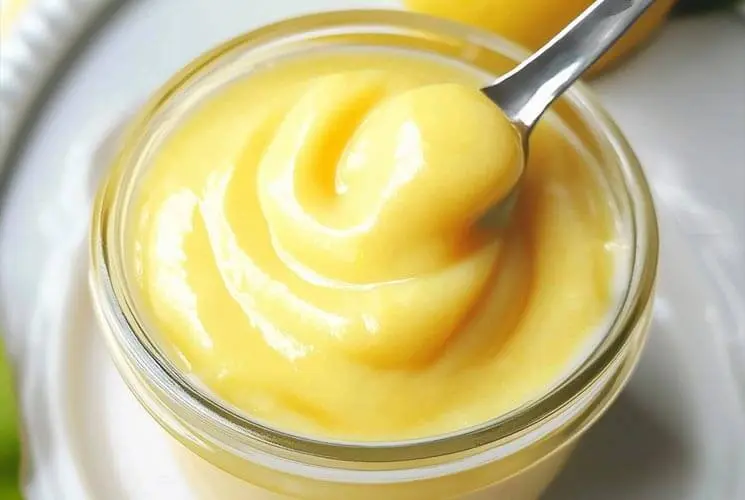Lemon curd is one of those magical creations that instantly brightens up any dessert. It’s a rich, velvety spread made from fresh lemon juice, sugar, eggs, and butter—balancing tangy citrus flavor with creamy sweetness. Think of it as the sunny cousin of jam or custard, bursting with bold lemon flavor.
What makes lemon curd so special? It’s that silky-smooth texture, that tart-but-sweet bite, and its ability to elevate even the simplest treats. You’ll find it layered in cakes, spooned into tart shells, spread on scones, or swirled into yogurt. It’s also a go-to filling for macarons and thumbprint cookies.
While store-bought lemon curd is convenient, homemade is next level. It’s fresher, brighter, and free of preservatives or thickeners. Plus, making it at home lets you tweak the sweetness or tartness exactly how you like it. Once you try it fresh, you may never go back to the jarred version again.
Ingredients Breakdown: What Goes into a Great Lemon Curd
Great lemon curd starts with simple ingredients—but each one plays an important role in creating that smooth, luxurious finish.
Fresh lemons
You’ll need both juice and zest. The juice provides bold citrus flavor, while the zest adds a fragrant, aromatic note. Always use fresh lemons, not bottled juice—it makes a huge difference in taste.
Sugar
Sugar does more than sweeten; it helps balance the sharpness of the lemon. You can adjust it to taste—more sugar for a milder curd, less for a sharp zing.
Eggs
Eggs thicken the curd and give it body. Some recipes use whole eggs, while others call for just the yolks for an even richer result. Either works—just be sure to whisk them thoroughly.
Butter
Butter is what gives lemon curd that creamy, silky mouthfeel. It also rounds out the tartness and adds richness.
Optional extras
A pinch of salt enhances the flavors. A splash of vanilla adds warmth. And if you’re in a hurry, a touch of cornstarch can help thicken faster—but it’s not traditional.
Pro tip: Zest your lemons before you juice them—it’s way easier that way!
Step-by-Step: How to Make Lemon Curd
Making lemon curd might sound fancy, but it’s surprisingly easy when you follow a few key steps. The trick is gentle heat and a bit of patience.
Step 1: Whisk the base
In a medium saucepan (or heatproof bowl if using a double boiler), whisk together the eggs, sugar, and lemon juice. Add the zest. This mixture should look smooth and well-combined before you apply any heat.
Step 2: Low and slow cooking
Set the pan over medium-low heat or place your bowl over a gently simmering pot of water (double boiler style). Whisk constantly—don’t walk away! You want the curd to heat slowly so the eggs thicken without scrambling.
This step can take anywhere from 8 to 15 minutes, depending on your heat source. The curd is ready when it’s thick enough to coat the back of a spoon. Drag your finger across it—if the line holds, it’s done.
Important: Never let it boil. Boiling can cause the eggs to curdle.
Step 3: Add butter
Once thickened, remove the pan from the heat and stir in the butter, one piece at a time, until fully melted. This step adds creaminess and sheen.
Step 4: Strain (optional but recommended)
For an ultra-smooth texture, strain the curd through a fine-mesh sieve into a clean bowl or jar. This removes bits of zest and any accidental egg solids.
Step 5: Chill and store
Let the lemon curd cool at room temperature, then refrigerate. It will thicken further as it chills—and the flavor gets even better!
Troubleshooting Common Lemon Curd Mistakes
Even seasoned cooks can hit a snag with lemon curd. Here’s how to avoid common issues:
Curdled or scrambled eggs?
This happens when the heat is too high or you stop whisking. Always cook on low heat and keep it moving.
Too thin?
If your curd didn’t set, it likely didn’t cook long enough. Return it to the stove and heat gently until thickened. It also thickens more as it cools.
Too thick or gummy?
Overcooked curd or too much cornstarch can make it gluey. Stick to a gentle simmer and skip the starch if possible.
Gritty texture?
That’s usually from sugar not dissolving. Whisk thoroughly before heating and make sure to strain after cooking for a silky finish.
Too sweet or sour?
Taste as you go! You can adjust sugar or lemon juice early in the cooking process for your perfect flavor balance.
Flavor Variations and Twists
Once you’ve nailed classic lemon curd, the possibilities are endless.
Other citrus versions
-
Lime curd: tangy and tropical—great for key lime tarts
-
Orange curd: sweeter, mellow—perfect for breakfast pastries
-
Grapefruit curd: more complex and slightly bitter—elegant and adult-friendly
Infused flavors
-
Vanilla: Adds a warm, bakery-style note
-
Ginger: Great for a spicy kick
-
Lavender or rosemary: Floral herbs pair beautifully with lemon—steep in the juice before straining
Make it less tart
Add a bit more sugar, or mix in a splash of orange juice to mellow the acidity. Meyer lemons also produce a naturally sweeter curd.
Vegan or dairy-free lemon curd
Replace eggs with cornstarch and non-dairy milk, or use aquafaba (chickpea water) as a thickener. Swap butter for coconut oil or vegan butter alternatives. The texture changes slightly but can still be smooth and rich.
Tip: Try layering different citrus curds in a glass for a vibrant dessert parfait!
How to Use Lemon Curd
Lemon curd is one of those versatile spreads that can do it all. Whether you’re hosting brunch or looking to dress up a weeknight dessert, there are so many fun and delicious ways to enjoy it.
Classic ways to serve lemon curd:
-
Scones, biscuits, toast – A dollop of lemon curd transforms any baked good into a tea-time treat.
-
Cake and tart fillings – Layer it between sponge cakes, or fill a pre-baked tart shell for a showstopper dessert.
-
Parfaits and trifles – Swirl it with whipped cream or yogurt, then layer with berries and cake cubes for a refreshing no-bake option.
Creative ideas to try:
-
Yogurt or cheesecake swirl – Add a spoonful of lemon curd to plain yogurt or swirl it into a cheesecake before baking.
-
Thumbprint cookies – Use it in the center of buttery shortbread cookies for a bright, citrusy bite.
-
Pancake or waffle topping – Move over syrup—lemon curd adds a tangy kick that pairs beautifully with sweet breakfast dishes.
Entertaining tip: Spoon lemon curd into mini tart shells, top with berries and mint, and serve as elegant brunch bites or quick party desserts.
Storing, Freezing & Shelf Life Tips
Lemon curd is best enjoyed fresh, but with proper storage, you can keep it delicious for days—or even months.
Refrigeration:
Store lemon curd in the fridge for 7 to 10 days. Make sure to transfer it into a clean, airtight glass jar or container. Glass is preferred over plastic, as it preserves the citrus flavor better and prevents staining.
Freezing:
Yes, lemon curd freezes beautifully. Spoon it into a freezer-safe jar or container (leaving a little room for expansion), and it’ll last up to 3 months. To use, thaw overnight in the refrigerator.
Pro tip: Avoid stirring it while it’s still partially frozen—wait until it’s completely thawed to preserve the texture.
Signs it’s gone bad:
If your lemon curd develops a sour or off smell, becomes discolored, or grows mold, it’s time to toss it. When in doubt, trust your senses.
Lemon Curd vs. Other Citrus Spreads
Lemon curd often gets lumped in with other citrus-based spreads, but it has its own unique identity.
Lemon curd vs. lemon pie filling:
Lemon pie filling typically contains cornstarch as a thickener and has a jelly-like texture, while lemon curd is egg-based and much richer and creamier. Think of pie filling as thicker and glossier—better for slicing, while curd is spoonable and velvety.
Lemon curd vs. jam or jelly:
Unlike jam or jelly, lemon curd doesn’t contain pectin and isn’t made from whole fruit pulp. It’s also more perishable and less sweet, with a buttery mouthfeel.
Is lemon curd the same as lemon butter?
Some use the terms interchangeably, but lemon butter can refer to a similar spread made with more butter or an added dairy element like cream. In most cases, they’re nearly identical.
Frequently Asked Questions
Can you overcook lemon curd?
Yes—overcooking leads to a grainy or curdled texture. Use gentle heat and remove from the stove as soon as it thickens.
Why is my lemon curd not thickening?
It may not have cooked long enough. Continue cooking over low heat, stirring constantly until it coats the back of a spoon.
Does lemon curd need to be refrigerated?
Absolutely. Because it contains eggs and butter, lemon curd must be stored in the refrigerator and kept in an airtight container.
Can I use lemon curd in baking?
Yes! It works beautifully as a filling for cupcakes, swirled into cheesecake, or baked into thumbprint cookies. Just avoid high heat directly on the curd—it’s best as a filling or topping added after baking.
Can I make lemon curd without eggs?
Yes, though the texture changes. Vegan lemon curds use cornstarch or coconut milk to thicken. It won’t be quite as silky but still flavorful.
What’s the best lemon for curd—Meyer or regular?
Meyer lemons are sweeter and less acidic, making them perfect for a mellow, fruity curd. Regular lemons bring a sharper, more traditional tartness.
Final Expert Tips for Best Results
-
Zest before you juice – It’s nearly impossible to zest a squeezed lemon.
-
Strain for silkiness – Don’t skip this step if you want professional-level texture.
-
Use stainless steel or glass cookware – Avoid aluminum, which reacts with the acid and can cause a metallic taste.
-
Add butter last – Stir it in after cooking for the smoothest finish.
-
Let it chill completely – Lemon curd sets up as it cools, developing a thicker consistency and deeper flavor.
Once you’ve mastered the basics, don’t be surprised if lemon curd becomes a staple in your fridge—it’s just that good.

Lemon Curd Recipe
Equipment
- Zester or Microplane
- Citrus juicer
- Whisk
- Medium saucepan or double boiler
- Fine mesh strainer (optional)
- Glass jars or containers for storage
Ingredients
- ½ cup fresh lemon juice from 2–3 lemons
- 1 tablespoon lemon zest
- ¾ cup granulated sugar
- 3 large eggs or 4 yolks for richer curd
- 6 tablespoons unsalted butter cut into cubes
- Pinch of salt optional
- ½ teaspoon vanilla extract optional
Instructions
- Whisk base: In a saucepan, whisk together eggs, sugar, lemon juice, zest, and a pinch of salt until well combined.
- Cook low and slow: Set over medium-low heat. Stir constantly for 8–12 minutes, until the mixture thickens and coats the back of a spoon.
- Add butter: Remove from heat. Stir in butter cubes until fully melted and smooth.
- Optional strain: For extra-smooth curd, strain through a fine mesh sieve into a clean bowl or jar.
- Chill: Let cool at room temperature, then refrigerate for 1 hour to set.
Notes
- For a richer curd, use only egg yolks.
- Don’t boil—heat slowly to avoid curdling.
- Use Meyer lemons for a sweeter, less acidic variation.
- Keeps in the fridge for 7–10 days, or freeze for up to 3 months.
Nutrition

